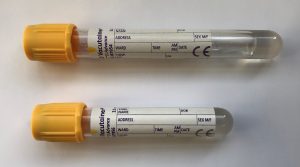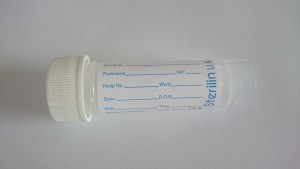CSF & paired serum


CSF collected into a sterile universal. Is is ESSENTIAL that a paired serum is collected at the same time for interpretation.
Since cerebrospinal fluid (CSF) is an ultrafiltrate of plasma, it has much lower concentrations of the highest molecular weight proteins such as IgG, IgA and IgM. Elevated CSF IgG levels can either be the result of diffusion of plasma IgG across an altered blood brain barrier or intrathecal synthesis. Patients with multiple sclerosis and other demyelinating disorders often have elevated CSF IgG concentrations due to intrathecal synthesis. One of the best methods to detect intrathecal IgG synthesis has been to examine CSF for the presence of oligoclonal bands (OCB) after separation of proteins by electrophoresis. IgG in normal CSF migrates as a faint diffuse zone, but in demyelinating diseases, IgG migrates as discrete oligoclonal bands.
Unconcentrated CSF should be compared directly with a serum sample run simultaneously in an adjacent track of the same agarose gel. Serum should be diluted to approximately the same IgG concentration as the CSF. Patient samples should be run in conjunction with negative and positive controls. An experienced pathologist should interpret the resulting patterns. Five different patterns may be observed.
| Pattern | Bands Observed | Associated Diseases |
| 1 | Polyclonal pattern (no discrete bands) in both serum & CSF |
Rare Multiple sclerosisMyelitis CNS vasculitis Paraneoplastic syndromes Systemic lupus erythematosis |
| 2 | Same number of OCB in serum & CSF |
MyelitisCNS vasculitits Paraneoplastic syndromes Lupus CNS infections Neoplastic meningitis Behcet Disease Rasmussen Disease Hashimoto encephalitis Lymphoproliferative disorders Hepatitis C |
| 3 | OCB in both serum & CSF CSF has at least 2 more bands than serum | Multiple sclerosisMost CNS infections |
| 4 | More than 2 OCB in CSF & polyclonal pattern in serum | Most Multiple sclerosis |
| 5 | Monoclonal band in both serum & CSF |
Normal individualsMultiple sclerosis CNS lymphoma CNS inflammatory disorders |
Patterns 3 and 4 are reported as positive for OCB. Although a single band difference between CSF and serum is not diagnostic of multiple sclerosis, more than one half of these patients will progress to a full oligoclonal pattern.
The occurrence of single monoclonal bands in CSF is uncommon. Approximately 50% of cases of monoclonal CSF bands occur without a corresponding serum band. Two thirds of patients with solitary CSF bands revert to a normal polyclonal pattern over time or retain the solitary band without evidence of disease. The remaining one third subsequently develops multiple sclerosis or another demyelinating syndrome
28 days
Referred test
Samples are sent to Oxford Immunology Laboratory, Churchill Hospital
Specimen Labelling Procedure